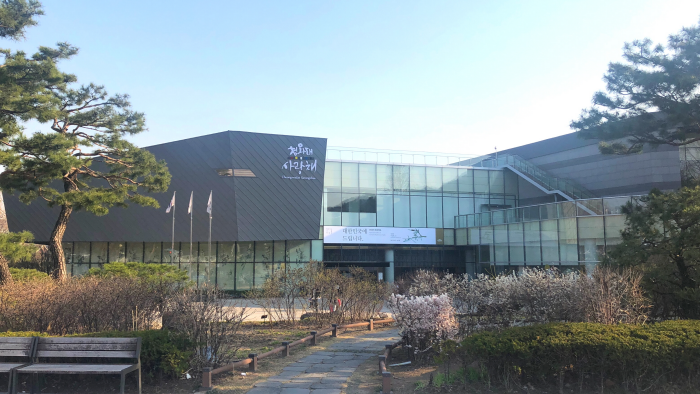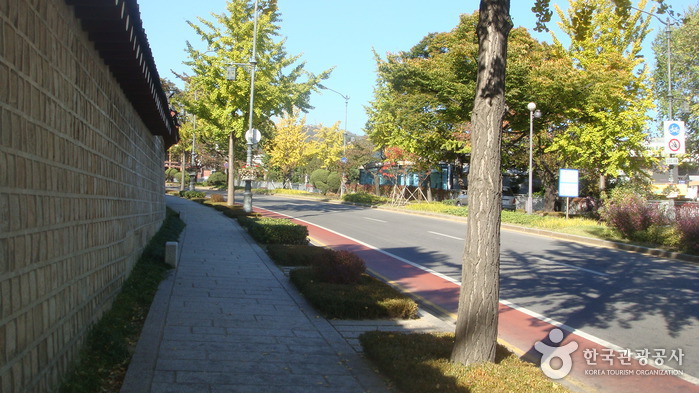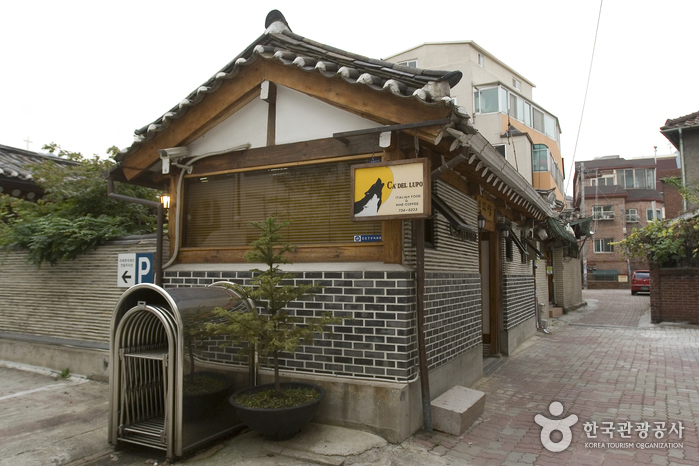Of one book and stay [Korea Quality] / 일독일박 [한국관광 품질인증/Korea Quality]
8.4Km 2021-03-29
11-1, Pirundae-ro 3-gil, Jongno-gu, Seoul
This hanok (traditional Korean house) is located in Seochon Village near Gyeongbokgung Palace. It is a modern C-shaped hanok centered around the inner courtyard, which is the first thing that the guests see after entering through the gate. While it is not expansive, white pebbles and a foot bath make this hanok a unique one. One can enjoy a foot bath while sitting on the porch.
The bedroom, which is located beyond the living room, is furnished with a queen-sized bed. Opening the screen doors brings one to the view of the kitchen area beyond the inner courtyard. A large table, plush sofa, and a small bookcase make the space ideal for books and discussions. Climbing the wooden ladder to the side of the kitchen brings one to the attic, which also doubles as a Korean-style room with a skylight. The kitchen is furnished with a refrigerator, microwave oven, gas stove, electric kettle, toaster, pots, utensils, wine glasses, and bottled water. There is a restroom with a bathtub. The standard occupancy of the house is 4 people.
Bali Tourist Hotel (발리관광호텔)
8.4Km 2020-04-21
210, Pungseong-ro, Gangdong-gu, Seoul
+82-2-488-5911
Formerly known as LA Tourist Hotel, Bali Tourist Hotel is equipped with 50 rooms and the only tourist hotel in Gangdong-gu. Guests at the hotel may take advantage of the hotel's proximity to tourist sites and Dunchon Traditional Market.
Cheong Wa Dae (Casa Azul) (청와대)
8.5Km 2024-05-17
Cheongwadae-ro 1, Jongno-gu, Seúl
Cheong Wa Dae (también conocida como Casa Azul) se compone del Edificio de la Oficina Principal, Yeongbingwan (Residencia de los Huéspedes de Estado), Chunchugwan (Pabellón de Primavera y Otoño), el parque Nokjiwon, Mugunghwa Dongsan y el santuario Chilgung. Las formas singularmente únicas de los edificios guardan un gran interés. Su estética sigue el estilo tradicional coreano. Las tejas azules y las suaves líneas curvas del techo del edificio principal son bellísimas. Aproximadamente 150.000 tejas componen el techo de Cheong Wa Dae, cada una de las cuales fueron cocidas al horno, en forma individual, de modo que son suficientemente fuertes como para ser usadas por más de un siglo. Mirando hacia la derecha encontrará Chunchugwan. El techo de Chunchugwan fue hecho de las tradicionales tejas de barro cocido y aquí es donde el presidente de la nación llevaba adelante sus conferencias de prensa. A la izquierda de la Oficina Principal, se halla Yeongbingwan. Esta construcción fue diseñada para alojar grandes conferencias y eventos oficiales durante las visitas de los invitados extranjeros. Luce muy lujosa y magnificente con sus 18 columnas de piedra que sustentan al edificio. Asimismo, puede pasear por el jardín Nokjiwon y el valle Mugunghwa. Nokjiwon es donde una sucesión de presidentes plantaron árboles en ocasiones memorables. Allí, hay un famoso árbol que tiene 310 años de edad. El valle Mugunghwa se encuentra lleno de flores de la rosa de Sharon, una fuente y una estatua del ave fénix, que conforman el lugar perfecto para la toma de fotografías. El lugar presenta un paisaje aún más bello entre julio y octubre, cuando las flores mugunghwa, la flor nacional, rompen sus pimpollos y cubren el jardín con su aroma. Todos los obsequios entregados al presidente se encuentran dispuestos aquí en exposición. Desde mayo de 2022, el predio de Cheong Wa Dae se encuentra abierto al público.
Dar un paseo por los alrededores de Cheong Wa Dae es un gran placer, por los paisajes atractivos y peculiares. Estos caminos de paseo se despliegan por un lado del palacio Gyeongbokgung pasando por Cheong Wa Dae y llegando al Parque de Samcheong-dong. El trayecto desde la puerta Dongmun del palacio Gyeongbokgung hasta Cheong Wa Dae es el recorrido más bello. Junto a un camino que se despliega por el centro, se encuentra el Muro de Piedra del Palacio Gyeongbokgung hacia la izquierda, las galerías de arte, y los edificios antiguos hacia la derecha. Junto al Muro de Piedra del Palacio Gyeongbokgung crecen árboles añejos que relajan y reconfortan a los que pasean junto a él. Gracias a sus coloridas hojas, el sendero se convierte en un paseo muy romántico durante la época de otoño. Cruzando la calle se encuentran la Galería Hyundai y el Museo Kumho, entre otros lugares artísticos, y también hay una variedad de cafeterías elegantes.
Hanok Guesthouse Dongchonchae [Korea Quality] / 한옥 게스트하우스 동촌재 [한국관광 품질인증/Korea Quality]
8.5Km 2021-03-26
21-10, Jahamun-ro 11-gil, Jongno-gu, Seoul
Built in 1939, Dongchonchae was designated as Seoul Well Hanok by the Seoul Metropolitan City in 2016. In 2020, this hanok (traditional Korean house) received the Certificate of KOREA QUALITY from the Korea Tourism Organization in the Heritage Hanok field in recognition of its historicity and quality of services. Dongchonjae is located in the western side of Gyeongbokgung Palace, at Seochon. When one passes through its main gate, one sees the yard, with anchae (women's quarters), sarangchae (men's quarters), and byeolchae (detached quarters) surrounding the plot. Anchae has four rooms, daecheong (wood-floored main hall), a kitchen, and a restroom. One of the rooms is used for tea ceremonies as well. Outside of the sarangchae and byeolchae, which are the living spaces for the owners, visitors have free access to the numaru (raised open floor) and the yard. The anchae’s rooms “Bom” and “Yeoreum” can accommodate 2 to 3 adults each, while the rooms “Gaeul” (Tea Room) and “Gyeoul” are optimal for two. The building is rented out as a whole, so no more than one group may stay in the building at any given time. Standard occupancy is four persons, and eight is the maximum number. There are two restrooms, one within the anchae building, one out in the backyard.
Cooking is not allowed in the kitchen, but guests are free to bring in outside food. Experience programs on offer include nighttime exploration of Seoul City Wall, tea ceremony, folk songs, and rice cake making. Additional payment is only required for rice cake making. Guests may choose between two types of complimentary breakfast: Korean, which comes with rice, soup, and three side dishes; and Western, which comes with bread, salad, and coffee. There are a 100-in screen and mini projector for film watching in the yard or daecheong. Towels, toiletries, hair dryer, bottled water, traditional tea, and capsule coffee are included. The kitchen is equipped with kitchen utensils, a microwave, and a coffee pot, enough for instant foods. Guests also have access to refrigerator and washing machine
Sarangchae de Cheong Wa Dae (청와대사랑채)
8.5Km 2023-05-30
Hyoja-ro 13-gil 45, Jongno-gu, Seúl
Sarangchae de Cheong Wa Dae es un espacio donde los visitantes pueden aprender sobre cultura coreana y la historia de los presidentes de Corea. Los visitantes pueden también conocer algunas anécdotas e historias relacionadas con Cheong Wa Dae y sentir el encanto de hacer turismo en Corea.
Museo Chusa en Gwacheon (추사박물관(과천))
8.5Km 2023-07-13
Chusa-ro 78, Gwacheon-si, Gyeonggi-do
Tumbas Reales Uireung en Seúl (서울 의릉) [Patrimonio Cultural de la Humanidad de la Unesco]
8.5Km 2020-12-18
Hwarang-ro 32-gil 146-20, Seongbuk-gu, Seúl.
+82-2-964-0579
Uireung son las tumbas del rey Gyeongjong (1688-1724, rey de 1720 a 1724), el 20º rey de la Ddinastía Joseon, y su segunda esposa la reina Seonui (1705-1730).
El rey Gyeongjong fue el primer hijo del rey Sukjong y Janghuibin, una de las concubinas del rey. El rey Gyeongjong nació débil y anémico, y falleció solo 4 años después de ser proclamado rey, sin ningún logro político de importancia. La reina Seonui fue princesa en 1718 y reina en 1720, cuando el tey Gyeongjong ascendió al trono. Está considerada una reina prudente. Las tumbas Uireung se diferencian de otras tumbas reales en que no están una al lado de la otra, sino que siguen la teoría geomántica y una está justo detrás de la otra.
Calle Frontal de Cheong Wa Dae (청와대 앞길)
8.5Km 2022-06-30
Gungjeong-dong, Jongno-gu, Seúl
La calle frontal de Cheong Wa Dae (también conocida como Casa Azul) está abierta al público e incluye el Hyoja Samgeori (intersección de tres calles) en Hyoja-dong y el Palpan Samgeori (intersección de tres calles) en Palpan-dong. Cuando se camina por la calle Hyoja-ro, desde la Estación de Gyeongbokgung del metro, se pueden ver una fuente, el jardín Mugunghwa, y los pabellones Daegogak y Yongbingwan. Al principio de la calle, enfrente de Cheong Wa Dae, árboles y hermosos jardines de flores decoran los dos lados de la misma, creando un agradable lugar para pasear.
Ca'del Lupo (까델루뽀)
8.5Km 2020-04-27
5-5, Jahamun-ro 16-gil, Jongno-gu, Seoul
+82-2-734-5233
Ca'del Lupo is an Italian restaurant, closely located to Paris Baguette in Hyoja-dong, Jongno-gu near Gyeongbokgung Palace Station. Though the restaurnat masters delicious homemade Italian cuisine on the inside, the exterior is wholly Korean. This unique combination of Hanok (traditional Korean house) style housing and Western foods is drawing a lot of people to Hyoja-dong. The great mix of both cultures can be seen in the sophisticated decorations and from the amazing food. The herbs they use are picked directly from the restaurant's personal garden. But to enjoy the atmosphere here, you will have to make a reservation far in advance.
Mercado Tongin (통인시장)
8.5Km 2024-01-24
Jahamunro 15-gil 18, Jongno-gu, Seúl.
![Of one book and stay [Korea Quality] / 일독일박 [한국관광 품질인증/Korea Quality]](http://tong.visitkorea.or.kr/cms/resource/43/2707643_image2_1.jpg)

![Hanok Guesthouse Dongchonchae [Korea Quality] / 한옥 게스트하우스 동촌재 [한국관광 품질인증/Korea Quality]](http://tong.visitkorea.or.kr/cms/resource/96/2705896_image2_1.jpg)

![Tumbas Reales Uireung en Seúl (서울 의릉) [Patrimonio Cultural de la Humanidad de la Unesco]](http://tong.visitkorea.or.kr/cms/resource/80/2690680_image2_1.jpg)


 Español
Español
 한국어
한국어 English
English 日本語
日本語 中文(简体)
中文(简体) Deutsch
Deutsch Français
Français Русский
Русский